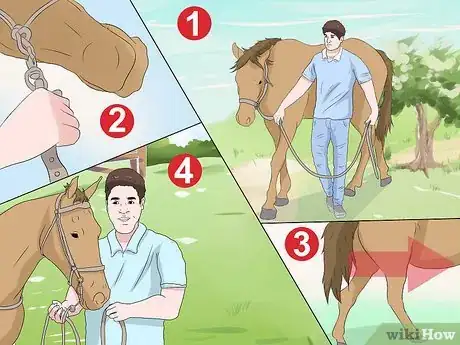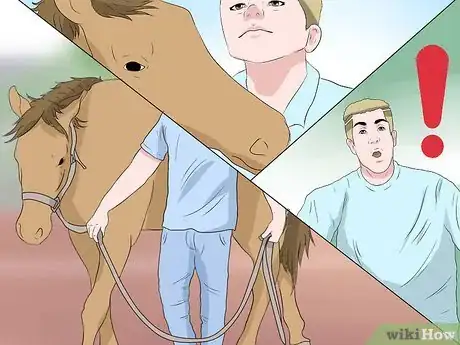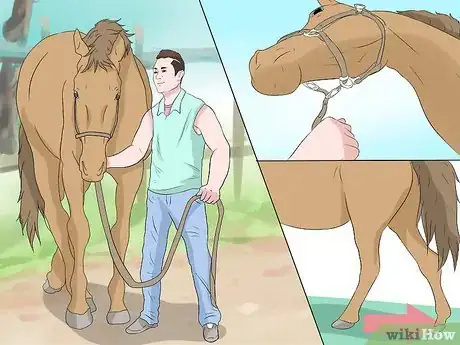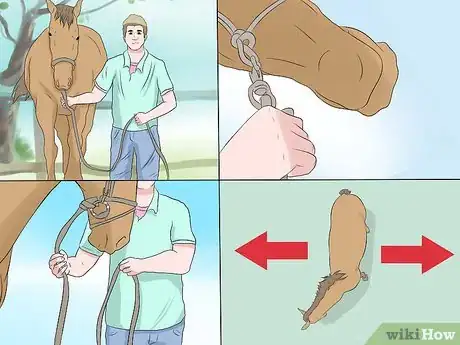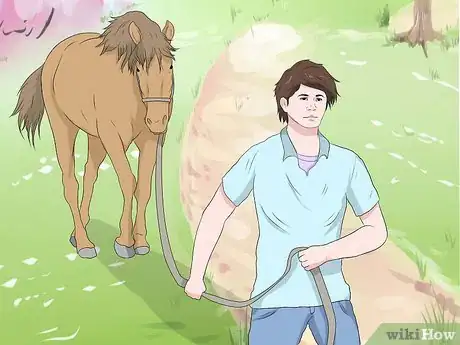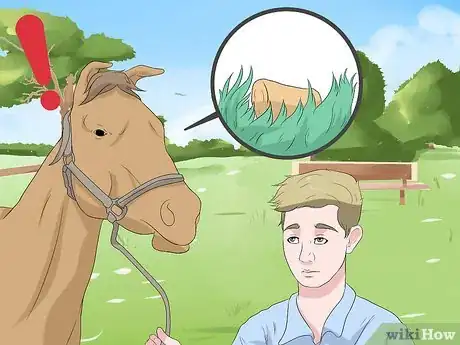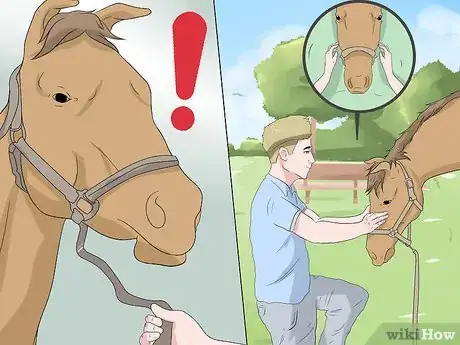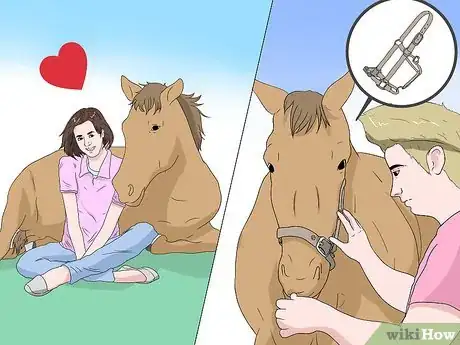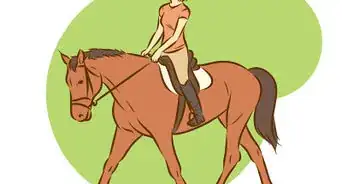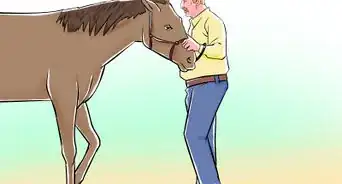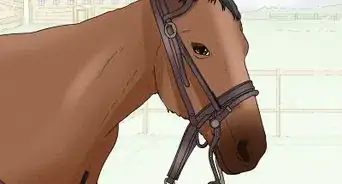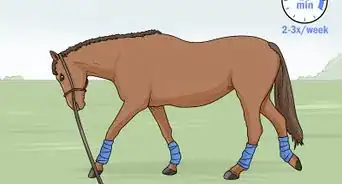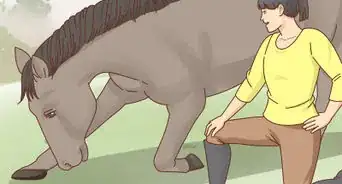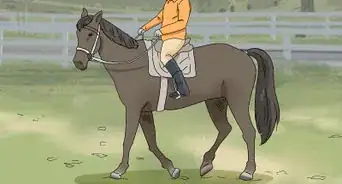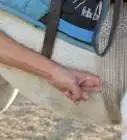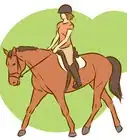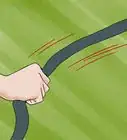This article was co-authored by Kate Jutagir. Kate Jutagir is an Equestrian Specialist, Hunter/Jumper Trainer, and the Owner of Blackhound Equestrian, a premier training barn located on 65 acres in Castro Valley, California. Originally designed to be a riding school used as a springboard for dedicated students into careers in the sport, Blackhound Equestrian has grown into a hunter/jumper training program for all levels focusing on providing a solid foundation needed for personal advancement in the sport. Kate has over 25 years of equestrian instruction and training experience. Her focus on developing horse and rider partnerships provides a complete equestrian education for both beginners and advanced riders alike.
There are 11 references cited in this article, which can be found at the bottom of the page.
This article has been viewed 89,193 times.
Walking your horse, or leading, is a daily activity for a horse owner. A horse must have basic leading skills before you can expect it to be trained to ride, drive, or any other activity. Training your horse to lead can take some patience and persistence in the early stages, but it provides a solid grounding for subsequent work.
Steps
Establishing Basic Directional Cues
-
1Attach the lead line. Once your horse is comfortable in the halter, you can begin training him to lead. First of all you need to attach a lead line to the halter. Standing on the left hand side of your horse, take the line in your right hand and hold it a foot or two away from his chin. Take hold of the remaining line in your left hand.
- You can fold the line in your left hand, but never wrap or tie it around your hand or wrist.[1]
- If he balks, or just has a sudden head movement, and you have no give in the line it could injure either or both of you.
-
2Teach him the cue for forwards. Make sure you are standing at the horse’s shoulder and facing in the same direction as him. Start by holding the lead rope under your horse’s chin, and then gently apply forward pressure. Keep the pressure consistent until he make a forward movement. As soon as he steps forward, release the pressure completely. Repeat this again and again until he moves as soon as you apply forward pressure.Advertisement
-
3Teach him to halt. As you have established that standing next to your horse and looking in the same direction indicates that you want to move forward, you can use your body position as a cue to halt. Turn to face your horse, and give an audio cue. Say something like “halt,” “stop,” “whoa,” or “stand.” Don’t pull back on the lead line when you stop, but do apply a little resistance pressure.[4]
-
4Establish the cue for back. Standing alongside your horse, bring the lead line down so it is directly beneath his chin. Then apply some gentle but consistent pressure on the line until he responds by making a backwards movement. The moment he shifts his weight back, release the pressure on the line. Wait a few seconds, and then repeat this again and again.
- If he moves in a different direction or becomes excitable, keep calm, don’t react, and maintain steady gentle pressure on the line.[5]
-
5Train him to turn left and right. You can train him to recognise cues to turn left and right in a similar way to the cues for forwards and back. Stand on the left of him and apply gentle consistent pressure to the line until he moves in the desired direction. Immediately release the pressure when he does, then wait and repeat. You can do this on the right hand side in much the same way. Just stand on the right and apply pressure to the lead line.[6]
- Repeat these training exercises again and again, until he responds quickly and correctly every time.
- Remember to be patient and gentle at all times, and reward him for good work.[7]
Leading Your Horse
-
1Lead from the front. When you are ready to lead your horse, you can do it from the lead position, or from the partner position. The lead position requires you to stand to the side and ahead of your horse. You walk ahead of him, and this helps to define your personal space, which you decide when he can and cannot enter.[8]
- Hold the line in your hand and allow some slack so you can move along together comfortably.
- You can try to time your steps in line with your horse’s stride so he sees that you are matching strides and that is part of the game.[9]
-
2Lead from the partner position. To lead from the partner position, you have to walk near the horse’s shoulder. The horse will learn to stay close to you, whether walking, trotting, or standing still. In this position, you will be leading and driving the horse at the same time. Generally you would only do this once you have mastered leading from lead position and have good understanding and relationship with your horse.
- You can lead from the partner position on either side of your horse, left or right.
- In the partner position your horse is in your space and you should be able to pull him back from you at all times.[10]
-
3Pay attention to the horse. When you are leading a horse, it’s vital that you pay close attention to him and the environment. You want to be able to spot any potential problems before they occur. If you see something that might frighten the horse or prompt him to run, be ready to react. If he starts to run, turn him in a narrowing circle until he stops.
- Do this by drawing him in one direction with the lead line, and then leading him round in a circle. You can start with a larger circle and then tighten it.[11]
- Don’t punish him for reacting or being scared.
- Allow him time to explore new environments, and spend time desensitizing him if he has particular problems.[12]
-
4Deal with problems. Sometimes when you are leading a horse, he might get startled and start moving around side to side, or even balking and rearing up. This can be a scary experience so it’s important that you stay calm and know how to react. Don’t pull back on the line, as this will only make him feel more trapped. Give him all the line to rear up he needs.
- The safest place to be is close enough to the horse that it can’t get any room to swing his legs and kick you.
- If you are within range move close to his shoulder, and you can even grab his mane if necessary.
- Don’t punish a horse for rearing, instead just interrupt them with clear instructions and carry on.[13]
-
5Help him relax. If you notice that you horse is anxious when you are leading him, there are things you can do to help calm and relax him. If he holds his head up, and his ears are pointing up, this indicates that he is not relaxed and may be distracted. You can help him relax by teaching him to lower his head on cue. Lowering his head will release and loosen his spine and reduce any anxiety.
- You can teach him to lower his head on cue, by standing alongside him and holding his lead line about two inches from where it is attached to the halter.
- Apply gentle consistent pressure down. Make sure you apply pressure straight down so he does not think you are asking him to move forwards or back.
- Hold consistent gentle pressure until he makes a downwards movement with his head. Even a very small movement should prompt a release.
- Repeat this over and over and reward him for good work.
- Once you have trained him to do this you can get him to lower his head when you lead him to help him relax.[14]
Using a Halter
-
1Get a nice soft halter. If you are teaching a young horse or foal to lead for the first time, you must first teach it to wear a halter. The halter (sometimes known as the headcollar) is the harness that you will place over the horse’s head, around the muzzle and up over the poll and ears. You can buy these at any horse supply or tack store, or you can always find one online.[15]
- Make sure you buy a soft halter, since hard poor quality nylon will rub and can cause sores on your horse’s sensitive skin.
- Remember, thin hard rope can be more severe than thick soft rope.
-
2Introduce your horse to the halter. If your horse or foal is not halter broken, you should spend some time getting him used to the halter before you put it on. If you have a young foal, you should get it used to people as soon as possible. Do this gradually. Start rubbing around the face and head to get it used to being touched and handled where the halter will go.
- Once the foal is happily accepting you touching its head, start rubbing the halter over its face and body and let it sniff it so it becomes comfortable with the new object.
- It is common to place a halter on a foal when it is just a few days old.
- Make sure that the halter is a good fit, and is not loose enough to snag or catch on anything.[16]
- Give your horse treats after putting its halter on the first few times so it associates the halter with rewards.[17]
-
3Put on the halter. Once you have built a relationship with your horse and he is comfortable with you touching his head, and has gotten used to the sight, feel and smell of the halter, you can try to put it on. When you’re both ready, gently slide the halter over his nose and onto his head. Fasten it on the side of the head, behind his ears. This can be tricky, so be patient and gentle at all times.
- Don’t get angry if he is awkward. Don’t shout or hit him as you will only cause him to associate haltering with negativity.
- Always try to end each training session with some success. If you can’t get him to wear it completely, make sure you get it over his nose, or one ear, before you finish.[18]
Community Q&A
-
QuestionHow do I train my horse to not want to move faster than me?
 Community AnswerWhen he walks in front of you, stop. Turn him in a circle untill he stops.
Community AnswerWhen he walks in front of you, stop. Turn him in a circle untill he stops. -
QuestionWhen I lead my horse, he always gets distracted by grass and pulls me over there, how do I teach him to stop?
 Community AnswerI would recommend a rope halter, because that puts slightly more pressure on the pressure points on his face when he's pulling away from you, and eventually that'll lead to him recognizing the pressure as "NO." This behavior can also be corrected without a rope halter. You can use the lead rope as an extension of your arm. When my horse does this, I usually grab the almost-end of my lead rope and smack her (lightly) on the chest with it so she knows not to do that. If she doesn't listen, I usually softly jangle the lead rope around so she associates that sound with "NO." If she still doesn't listen, I gradually increase the pressure.
Community AnswerI would recommend a rope halter, because that puts slightly more pressure on the pressure points on his face when he's pulling away from you, and eventually that'll lead to him recognizing the pressure as "NO." This behavior can also be corrected without a rope halter. You can use the lead rope as an extension of your arm. When my horse does this, I usually grab the almost-end of my lead rope and smack her (lightly) on the chest with it so she knows not to do that. If she doesn't listen, I usually softly jangle the lead rope around so she associates that sound with "NO." If she still doesn't listen, I gradually increase the pressure. -
QuestionHow old should a foal be to put a halter on him?
 JniloobCommunity AnswerA foal can be any age to put a halter on him. There is no specific age; even a newborn can wear a halter!
JniloobCommunity AnswerA foal can be any age to put a halter on him. There is no specific age; even a newborn can wear a halter!
References
- ↑ http://www.horses-and-ponies.com/horse-care/basic/how-to-halter-a-horse-or-pony/
- ↑ http://www.equusite.com/articles/ground/groundHalterBreaking.shtml
- ↑ http://www.horses-and-horse-information.com/articles/horse-lead-training.shtml
- ↑ http://www.horses-and-horse-information.com/articles/horse-lead-training.shtml
- ↑ http://www.equusite.com/articles/ground/groundHalterBreaking.shtml
- ↑ http://animals.mom.me/right-way-halter-break-horse-2158.html
- ↑ http://www.equusite.com/articles/ground/groundHalterBreaking.shtml
- ↑ http://horsefulnesstraining.com/groundwork-knowledgebase/groundwork-exercises-5-basics/
- ↑ http://www.meredithmanor.edu/features/articles/drm/lead.asp
- ↑ http://horsefulnesstraining.com/groundwork-knowledgebase/groundwork-exercises-5-basics/
- ↑ http://www2.ca.uky.edu/agc/pubs/4af/4af05ma/4af05ma.htm
- ↑ http://nasdonline.org/1040/d000838/leading-horses-safely.html
- ↑ http://www.horses-and-horse-information.com/rearing.html
- ↑ http://www.equusite.com/articles/ground/groundLeadingRelaxed.shtml
- ↑ http://www.horses-and-ponies.com/horse-care/basic/how-to-halter-a-horse-or-pony/
- ↑ http://animals.mom.me/right-way-halter-break-horse-2158.html
- ↑ Kate Jutagir. Equestrian Specialist & Trainer. Expert Interview. 31 March 2020.
- ↑ http://animals.mom.me/right-way-halter-break-horse-2158.html
About This Article
To train a horse to lead, start by petting your horse's head, so it gets used to being touched where the halter will go. Then, rub the halter over its face and let it sniff it. Once your horse has gotten used to the halter, place it over its head and muzzle, and attach the lead line. From here, you should teach your horse the cue for "forwards," "halt," "left," and "right," by applying gentle consistent pressure to the lead line in the direction you want the horse to go. For example, to teach your horse to move forward, hold the lead rope under its chin, then pull it forward until your horse steps forward. Continue training your horse until it responds quickly and correctly every time. For more advice, including how to deal with problems while training a horse to lead, keep reading!

